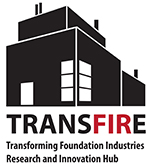TransFIRe researchers from the Sheffield Hallam University have been investigating the composition of commercial glass currently present in the UK market following a lack of recent research and data on the subject.
The study involved sampling and analysing the compositions of over 30 commercial container and float glass samples from the UK market and found a number of different properties within the glass that could bring about significant potential for energy saving in its production.
Based on the results obtained from the compositional analysis, the performance of these commercial glasses was evaluated using multiple analysis methods and property models. These analyses reveal that glasses of the same colour and function exhibit different properties, with a difference in the estimated melting temperature (Log 2 viscosity) of over 20 degrees Celsius in some cases.

Fig.1 Melting temperature difference between current UK container glasses: 21oC.
At present, there is a significant variation in the melting temperature among different glass factories operating at the same technological level, which highlights the substantial potential for energy savings for some commercial glass.
The most recent study of this kind dates back over 20 years and there is no publicly available literature on the composition of commercial glass.
In contrast to common beliefs, there are noteworthy distinctions in the composition of commercial glass compared to glass compositions from 30 to 40 years ago. The current compositions have undergone significant changes and are distinctly different.

Fig.2 Principal component analysis of current container glasses composition (in red and black) and historical glass composition (in cyan).
The composition of glass has been passively reliant on the level of glass equipment technology, and people have not yet, except for rare cases, recognized the necessity of deliberately reducing the melting temperature in practice.
In contrast to previous practices, the development of glass compositions with reduced melting points, aimed at achieving net-zero goals, will be an active process that demands proactive collaboration in areas such as melting, process control, forming, and furnace design under existing conditions.
Wei Deng, Paul Bingham, Ell Wakelin and Erhan Kilinc

